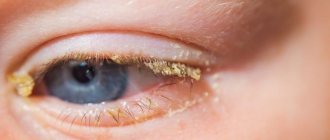Adenoviral conjunctivitis (pharyngo-conjunctival fever) is an infectious and inflammatory disease caused by adenoviruses and occurring with signs of damage to the conjunctiva (swelling of the eyelids, discharge from the eyes, burning, pain), symptoms of nasopharyngitis and increased body temperature. Outbreaks of the disease are most often recorded during the cold season among children attending organized groups.
Symptoms of adenoviral conjunctivitis
Causes and risk factors
Sporadic cases of adenoviral conjunctivitis are most often caused by adenovirus types IV, VI, VII and X. Epidemic cases are usually caused by adenoviruses III, VIIa and XI types.
The infection is transmitted through household contact or airborne droplets. When sneezing, coughing or through dirty hands, the adenovirus enters the mucous membrane of the eyeball.
Risk factors that increase the risk of developing adenoviral conjunctivitis are:
- stress;
- hypothermia;
- injuries of the organ of vision (including surgical ones);
- non-compliance with the rules of wearing and caring for contact lenses;
- swimming in public pools and open reservoirs.
From the moment of infection until the first symptoms of adenoviral conjunctivitis appear, 2 to 10 days pass (in most cases, the incubation period is 5–7 days). During their life activity, adenoviruses lead to the destruction of epithelial cells, which is characterized by nucleolar hypertrophy, chromatin breakdown, and vacuolization.
Complications
Lack of treatment for adenoviral conjunctivitis in adults and children leads to bacterial complications. Dry eye syndrome also often occurs as a result of the disease. A chronic inflammatory process can provoke the development of otitis media, tonsillitis, and toxic-allergic forms of conjunctivitis.
To reduce the risk of complications it is necessary:
- begin treatment when the first symptoms of the inflammatory process and viral infection appear;
- pay special attention to hygiene procedures that help prevent the spread of infection to nearby healthy tissues;
- Contact an ophthalmologist if any damage or signs of inflammation of the conjunctiva appear.
To prevent the spread of infection, all sick people must be temporarily isolated from healthy people. It is important to regularly carry out wet cleaning of premises and ventilate offices and living rooms, especially in the winter season, when viral diseases are common and immunity is reduced.
Read in a separate article: How and how to quickly cure conjunctivitis in an adult
You can become infected in an ophthalmologist's office if the medical staff does not pay due attention to disinfection and sterilization of the instruments used. In medical institutions, quartz treatment is regularly carried out, which destroys viruses and potentially dangerous microorganisms.
On a note! Adenoviruses can enter the mucous membrane while swimming in contaminated ponds and public pools. Visit such places with caution if you are predisposed to severe conjunctivitis and viral diseases.
Symptoms of adenoviral conjunctivitis
The first symptoms of adenoviral conjunctivitis are:
- headache;
- increased body temperature;
- dyspeptic disorders;
- submandibular lymphadenitis;
- nasal congestion;
- runny nose;
- sore throat;
- dry cough.
Headache, lacrimation, fever are the main symptoms of adenoviral conjunctivitis
After a few days, the body temperature decreases, and then it rises again. At this moment, patients begin to show signs of damage to the conjunctiva, first in one and then in the other eye:
- redness and swelling of the eyelids;
- itching;
- burning;
- foreign body sensation;
- mild blepharospasm;
- photophobia;
- lacrimation;
- light discharge of a mucous or mucopurulent nature.
Hyperemia (redness) of the conjunctiva covers all its parts, and also extends to the lower and semilunar fold, the lacrimal caruncle.
The catarrhal form of adenoviral conjunctivitis is characterized by mild symptoms of local inflammation. The amount of discharge is insignificant, redness of the mucous membrane of the eyes is moderate. The duration of the disease does not exceed a week. Complications from the cornea do not develop.
With follicular adenoviral conjunctivitis, follicles (small vesicles) 1-2 mm in size, filled with translucent gelatinous contents, appear on the mucous membrane of the eyes. They can cover the entire surface of the mucous membrane or concentrate in the corners of the eyelids.
Attention! Photo of shocking content. To view click on
. Adenoviral conjunctivitis in children in 25% of cases is presented in a membranous form. The disease is characterized by the appearance of thin, delicate films of a grayish-white color on the conjunctiva. In most cases, they can be easily removed with a cotton swab, but sometimes they take the form of dense fibrous deposits adhered to the mucous membrane. In this case, they are difficult to remove; after removal, the areas of the conjunctiva under them bleed. In some patients, infiltrates and hemorrhages form in the subconjunctival space. After recovery, they completely resolve. With membranous adenoviral conjunctivitis in children and most adults, the general condition suffers: body temperature rises to 38.5–39.5 ° C, general malaise, weakness, and headache appear. The duration of the febrile period ranges from 3 to 10 days.
Forms of the disease
With adenovirus infection, conjunctivitis is acute. According to its course, acute adenoviral conjunctivitis is divided into several forms:
- Catarrhal form: uncomplicated, passes quickly (usually within a week), symptoms are not too pronounced, can occur without fever.
- Film conjunctivitis: the course is more severe, characterized by the formation of films on the conjunctiva. The general symptoms are more severe, the illness lasts longer than a week, the temperature can rise to 38 - 39 degrees. Membranous conjunctivitis is observed in 25% of cases.
- Follicular form: expressed by rashes on the eyelids. Translucent bubbles with pathological fluid form, especially in the fold area and in the corner of the eye.
Diagnostics
It is possible to assume pharyngo-conjunctival fever in a patient if there is a history indicating contact with a patient suffering from this disease. During the examination, attention is paid to the combination of signs of conjunctivitis with regional lymphadenopathy and inflammation of the upper respiratory tract.
Confirmation of the diagnosis is carried out by virological, cytological and serological research methods. For early diagnosis of the disease, an immunofluorescent method is used, which makes it possible to detect specific viral antigens in the mucous membrane of the eye.
Adenovirus DNA can be detected in scrapings from the conjunctiva using a polymerase chain reaction (PCR), which is highly informative. Enzyme-linked immunosorbent assay (ELISA) and complement fixation reaction (FFR) allow us to determine the content of antibodies to adenoviruses in blood serum. For adenoviral conjunctivitis, the diagnostic criterion is an increase in the concentration of antibodies by at least 4 times.
ELISA for adenoviral conjunctivitis reveals an increase in antibodies to adenoviruses by more than 4 times
To isolate and identify adenoviruses in cell culture, a virological study of discharge from the conjunctiva is performed.
Sporadic cases of adenoviral conjunctivitis are most often caused by adenovirus types IV, VI, VII and X. Epidemic cases are usually caused by adenoviruses III, VIIa and XI types.
In the follicular form of adenoviral conjunctivitis, differential diagnosis is carried out with trachoma. With trachoma, the follicles are localized in the upper eyelid, and in addition, the disease is not accompanied by fever and symptoms of nasopharyngitis. The filmy form of adenoviral conjunctivitis is in some cases mistaken for ocular diphtheria.
In what forms does the disease manifest itself in childhood?
Keep in mind! In childhood, adenoviral conjunctivitis can manifest itself in one of three forms:
- Catarrhal . The mildest type of disease, which is local in nature. A thorough approach to treatment is not required, and in most cases the course of therapy lasts no more than a week. Complications are almost completely excluded. The distinctive symptoms of this form are profuse lacrimation and severe redness of the conjunctiva.
- Follicular. In addition to the symptoms of the catarrhal form, there is loosening of the mucous membranes of the eyes and the formation of vesicular inflammations on them, in which a clear liquid is formed. The mucous membranes swell, and cold symptoms become apparent.
- Membranous. This form develops in every fourth case. As the name implies, with this type of pathology, a white-gray film is formed on the conjunctiva, which in the initial stages of the disease is easily removed with cotton swabs or swabs. But in advanced conditions, the plates become denser and tightly connect to the mucous membrane of the eyes. Sometimes this leads to serious damage to the mucosa and bleeding. Treatment can take about a week and a half and requires a comprehensive approach.
Treatment of adenoviral conjunctivitis
Therapy for adenoviral conjunctivitis is carried out on an outpatient basis. In the first week of the disease, antiviral drugs are instilled into the conjunctival sac 6–8 times a day. In the second week, the frequency of their use is reduced to 2-3 times a day. Ointments with an antiviral effect can also be used, which are placed behind the eyelids 3-4 times a day.
In order to prevent the addition of a secondary bacterial infection, the use of eye drops and ointments with antibiotics or sulfonamides is indicated.
Antiviral eye drops are prescribed to treat adenoviral conjunctivitis.
During the course of treatment of adenoviral conjunctivitis, patients are prescribed antihistamines.
To prevent the development of xerophthalmia (dry eye syndrome), patients are recommended to instill moisturizing artificial tear eye drops several times a day.
How to treat viral conjunctivitis?
Treatment is carried out with the help of antiviral drugs, although not everyone considers them effective, especially in the midst of the disease. The best remedy for viral diseases is drugs that strengthen the immune system. They help the body quickly suppress the proliferation of viruses. To prevent the addition of a bacterial infection, antibacterial drops and ointments are prescribed. Blisters that occur with herpes are treated with brilliant green. It is very important to maintain hygiene. Initially, conjunctivitis affects only one eye, but the risk of infection spreading to the second is quite high. Both eyeballs are always treated, even if inflammation appears only on one of them.
Prevention
Prevention of infection with adenoviral conjunctivitis includes timely isolation of sick children from an organized group, regular wet cleaning, ventilation of premises, as well as careful adherence to personal hygiene rules.
Swimming pools require careful monitoring of chlorination and water compliance with current sanitary standards.
To prevent iatrogenic infection of patients with adenovirus infection, it is necessary to thoroughly sterilize and disinfect medical instruments (eye sticks, pipettes), and carry out routine and general cleaning in the ophthalmology office using disinfectants and subsequent quartz treatment.
Video from YouTube on the topic of the article:
Causes of conjunctivitis
There are more than 150 types of viruses that can infect the organ of vision. In medical practice, there are 5 common pathogens of conjunctivitis:
- adenovirus;
- picornovirus;
- enterovirus;
- herpes virus (Zoster, cytomegalovirus, Epstein-Barr);
- Coxsackie virus.
In 85% of cases in adults, the causative agent of the disease is an adenovirus. Infection occurs mainly through contact with a carrier of the infection.
Often the pathology develops against the background of measles, mumps, influenza and chickenpox. Therefore, from the first days of the disease, the child needs to take preventive measures to prevent the spread of infection to the eye area. The risk of infection increases with weakened immunity. In children, the immune system is in the formative stage, so they are advised to be isolated from the sick until complete recovery (about 12 days). Otherwise, conjunctivitis can lead to an epidemic.
The main reasons for the development of conjunctivitis include:
- frequent contact of dust with eyes;
- weakened immunity due to chronic pathologies;
- failure to comply with personal hygiene rules;
- penetration of the virus into the body.
The acute form of the disease is observed when affected by adenoviruses of types 3, 4, 7. The epidemic nature of the lesion is recorded during infection with adenoviruses 8 and 19 types.











